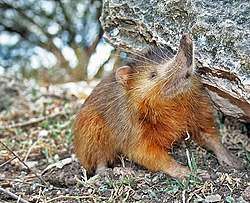Eulipotyphla
Eulipotyphla ("truly fat and blind"[3]) is an order of mammals suggested by molecular methods of phylogenetic reconstruction, and includes the laurasiatherian members of the now-invalid polyphyletic order Lipotyphla, but not the afrotherian members (tenrecs and golden moles, now in their own order Afrosoricida). Lipotyphla in turn had been derived by removing a number of groups from Insectivora, the previously used wastebasket taxon.
| Eulipotyphla Temporal range: Eocene to present | |
|---|---|
 | |
| Clockwise from upper left: a solenodon, hedgehog,[note 1], mole and shrew | |
| Scientific classification | |
| Kingdom: | Animalia |
| Phylum: | Chordata |
| Class: | Mammalia |
| Magnorder: | Boreoeutheria |
| Clade: | Laurasiatheria |
| Order: | Eulipotyphla Waddell et al., 1999 |
| Families | |

Eulipotyphla comprises the hedgehogs and gymnures (family Erinaceidae, formerly also the order Erinaceomorpha), solenodons (family Solenodontidae), the desmans, moles, and shrew-like moles (family Talpidae) and true shrews (family Soricidae). True shrews, talpids and solenodons were formerly grouped in Soricomorpha; however, Soricomorpha has been found to be paraphyletic, since erinaceids are the sister group of shrews.[4][5][6]
Classification
- Order Eulipotyphla (= 'Lipotyphla' - Afrosoricida = 'Erinaceomorpha' + 'Soricomorpha')
- Family Erinaceidae[7]
- Subfamily Erinaceinae: hedgehogs
- Subfamily Galericinae: gymnures or moonrats
- Family Soricidae[8]
- Subfamily Crocidurinae: white-toothed shrews
- Subfamily Soricinae: red-toothed shrews
- Subfamily Myosoricinae: African white-toothed shrews
- Family Talpidae[9]
- Subfamily Talpinae: Old World moles and desmans
- Subfamily Scalopinae: New World moles
- Subfamily Uropsilinae: shrew-like moles
- Family Solenodontidae: solenodons
- † Family Nesophontidae: extinct West Indian shrews
- † Family Amphilemuridae
- † Family Plesiosoricidae
- Family Erinaceidae[7]
Family-level cladogram of extant eulipotyphlan relationships, following Roca et al. and Brace et al.:[5][10]
| Eulipotyphla |
| ||||||||||||||||||||||||
The upper and lower basal subclades within the tree are the suborders Solenodonota and Erinaceota, respectively.[10] These two branches are estimated to have split ~72-74 million years (Ma) ago.[10][1][2] The Nesophontidae and Solenodontidae are thought to have separated roughly 57 Ma ago.[10] Split times for talpids vs. soricids plus erinaceids, and for soricids vs. erinaceids, have been estimated at around 69 Ma and 64 Ma ago, respectively.[11]
Notes
- Either a European hedgehog or a northern white-breasted hedgehog
References
- de Lazaro, Enrico (19 March 2018). "Solenodon Genome Sequenced". Sci-News.com. Retrieved 2019-06-23.
- Grigorev, K.; Kliver, S.; Dobrynin, P.; Komissarov, A.; Wolfsberger, W.; Krasheninnikova, K.; Afanador-Hernández, Y. M.; Brandt, A. L.; Paulino, L. A.; Carreras, R.; Rodríguez, L. E.; Núñez, A.; Brandt, J. R.; Silva, F.; Hernández-Martich, J. D.; Majeske, A. J.; Antunes, A.; Roca, A. L.; O'Brien, S. J.; Martínez-Cruzado, J. C.; Oleksyk, T. K. (2018). "Innovative assembly strategy contributes to understanding the evolution and conservation genetics of the endangered Solenodon paradoxus from the island of Hispaniola". GigaScience. 7 (6). doi:10.1093/gigascience/giy025. PMC 6009670.
- Hassan, Mo (2009-10-11). "British Wildlife: N". The Disillusioned Taxonomist blog. Retrieved 2015-11-26.
- Douady, C. J.; Chatelier, P. I.; Madsen, O.; de Jong, W. W.; Catzeflis, F.; Springer, M. S.; Stanhope, M. J. (October 2002). "Molecular phylogenetic evidence confirming the Eulipotyphla concept and in support of hedgehogs as the sister group to shrews". Molecular Phylogenetics and Evolution. 25 (1): 200–209. doi:10.1016/S1055-7903(02)00232-4.
- Roca, A. L.; Bar-Gal, G. K.; Eizirik, E.; Helgen, K. M.; Maria, R.; Springer, M. S.; O'Brien, S. J.; Murphy, W. J. (2004-06-10). "Mesozoic origin for West Indian insectivores". Nature. 429 (6992): 649–651. Bibcode:2004Natur.429..649R. doi:10.1038/nature02597. PMID 15190349.
- Bininda-Emonds, O. R. P.; Cardillo, M.; Jones, K. E.; MacPhee, R. D. E.; Beck, R. M. D.; Grenyer, R.; Price, S. A.; Vos, R. A.; Gittleman, J. L.; Purvis, A. (2007-03-29). "The delayed rise of present-day mammals". Nature. 446 (7135): 507–512. Bibcode:2007Natur.446..507B. doi:10.1038/nature05634. PMID 17392779.
- Kim, N.H.; Lim, S.J.; Chae, H.M.; Park, Y.C. (2017). "Complete mitochondrial genome of the Amur hedgehog Erinaceus amurensis (Erinaceidae) and higher phylogeny of the family Erinaceidae". Genetics and Molecular Research. 16 (1). doi:10.4238/gmr16019300.
- Dubey, S.; Salamin, N.; Ohdachi, S.D.; Barrière, P.; Vogel, P. (2007). "Molecular phylogenetics of shrews (Mammalia: Soricidae) reveal timing of transcontinental colonizations". Molecular Phylogenetics and Evolution. 44 (1): 126–137. doi:10.1016/j.ympev.2006.12.002.
- He, K.; Shinohara, A.; Helgen, K.M.; Springer, M.S.; Jiang, X.-L.; Campbell, K.L. (2017). "Talpid Mole Phylogeny Unites Shrew Moles and Illuminates Overlooked Cryptic Species Diversity". Molecular Biology and Evolution. 34 (1): 78–87. doi:10.1093/molbev/msw221.
- Brace, S.; Thomas, J. A.; Dalén, L.; Burger, J.; MacPhee, R. D. E.; Barnes, I.; Turvey, S. T. (2016). "Evolutionary History of the Nesophontidae, the Last Unplaced Recent Mammal Family". Molecular Biology and Evolution. 33 (12): 3095–3103. doi:10.1093/molbev/msw186. PMID 27624716.
- Springer, M. S.; Murphy, W. J.; Roca, A. L. (2018). "Appropriate fossil calibrations and tree constraints uphold the Mesozoic divergence of solenodons from other extant mammals". Molecular Phylogenetics and Evolution. 121: 158–165. doi:10.1016/j.ympev.2018.01.007.